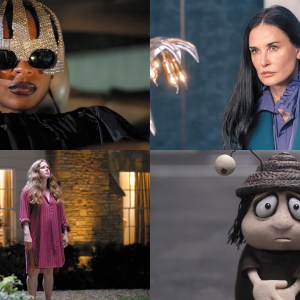By providing your information, you agree to our Terms of Use and our Privacy Policy. We use vendors that may also process your information to help provide our services. This site is protected by reCAPTCHA Enterprise and the Google Privacy Policy and Terms of Service apply.
‘Ripley’ Review: Andrew Scott’s Striking Netflix Series Pulls Off Its Own ‘Talented’ Twist


Animals are everywhere in “Ripley.” From the opening flash-forward to the closing montage, the latest adaptation of Patricia Highsmith’s Tom Ripley novels finds furry friends in frame after frame. Far from surplus scenery — Steven Zaillian‘s elegant vision of ’60s era Italy does not lack for beauty — these creatures are active characters. A grazing sheep finds a clue. A prowling cat produces a lead. A snake eludes detection inside a pair of loafers — and yes, in this case, a reptile is also an animal because the snake in question is Ripley himself: a slippery, second-rate con man with a cold-blooded stare, slicked-back locks, and vice-like grip on his prey. Embodied by Andrew Scott, Ripley follows a familiar pattern yet takes a distinct shape. He’s older, but not wiser; meaner, but more level-headed; greedier, but almost purely so.
This “Ripley” is a different animal.
First introduced in Highsmith’s 1955 novel “The Talented Mr. Ripley,” the title character is perhaps best known today (with apologies to bibliophiles with fond memories of the books and cinephiles who prefer “The American Friend” or “Purple Noon”) from Anthony Minghella’s 1999 film of the same name. Matt Damon stars as an American sent to Italy to retrieve a wealthy Manhattanite’s wayward son, but once he steps foot on the Boot’s sandy shores, the posh life in front of him proves irresistible, as does the golden boy (a positively gleaming Jude Law) he’s meant to bring home. A life of boating and beaching (or is it just beach?) tantalize our New York lonely boy, but that’s before his deceitful seeds are given too much sun, and a crime of passion pushes him to seize increasingly illicit opportunities in order to maintain the life he covets.
Love and envy, entitlement and greed, conformance and defiance. These are the competing elements driving Minghella’s twisted summer dream, but they’re not the keys to Zaillian’s “Ripley” — nor is it a straight adaptation of Highsmith’s novel, even if many of the beats stay true to the book. This “Ripley” starts in New York, where Tom is scraping together a living wage via mail fraud. He waits outside a doctor’s office, intercepts the day’s deliveries to snag any incoming checks, and responds to each sender himself, redirecting their “delinquent” payments to his own collections company. Given the nonchalance with which he goes about his routine, you get the sense he’s been conning for some time. He’s not particularly good at it, based on his living conditions (a disgusting halfway house with weird noises, bad plumbing, and zero privacy), but Tom has an eye for the details and — just as vital to a career criminal — knows when to push his luck and when to pull back.
Enter Herbert Greenleaf, the owner of a Long Island shipping company and a twice-too-trusting fool. Mr. Greenleaf’s son, Dickie (Johnny Flynn), has been living in Italy off a trust now inaccessible to his father, which poses a problem because the young man is simply too… happy. Boating by day, drinking by night, taking week-long trips to Rome, Naples, or wherever the wind carries him, Dickie is making the most of the life his father afforded him. Well, dear old dad has decided it’s time for the son he named after his penis to get back to work: He wants Dickie to return to New York and put in a few hours behind a desk by the docks, so he can take over the business when Herbie retires, thus preserving the family riches well into the future.

OK, Herbie didn’t say all that, but it’s not far off from what Tom hears — if he hears anything beyond “a paid trip to Italy where a minted mark awaits.” The narrative tracks established beats from there, albeit with a few twists. Unlike other tellings, this Tom always plans on stealing Dickie’s identity. That’s just who he is: A lifetime of lawbreaking keeps him on constant lookout for potential scores (like ripping off an affluent American abroad), just as it removes him from the practical sensibilities of upright citizens. While palling around with his “old friend” Dickie, Tom is quick to spot a fellow charlatan, yet he can’t comprehend why his well-off buddy might balk at, say, working with the Italian mob. Such a disconnect from reality applies to his personal life, as well, which is all but nonexistent. Tom’s sexual preferences, which were boiling over in Minghella’s searingly sexy “Talented Mr. Ripley,” play a part here, but as the series rolls out, they’re far less of an incentive.
Which brings us to another one of “Ripley’s” distinguishing factors: how it unfolds. Zaillion serves as the primary creative force, writing and directing every episode, and while he does nod to his other black-and-white European saga (“Schindler’s List”) via one curious yet unmistakable reference, it’s his only other TV credit that sheds light on “Ripley.” HBO’s 2016 limited series, “The Night Of,” is a criminal procedural about an innocent man who loses his innocence as he’s ground down by the wheels of justice. “Ripley” is also a criminal procedural — obsessed with process, from the execution of a killing to its extensive, exhausting cover-up — and although its subject is extremely guilty, the particulars of the Italian legal system (in 1961) are instrumental to Tom’s fate.
Zaillian’s meticulous telling emphasizes the significance of key details. Everything from a streak of blood in a bathtub to an old pair of shoes is given ample weight almost entirely through the camera’s eye. But the approach also acknowledges the impact of sheer luck. Lingering close-ups build tension around possible oversights that could get Ripley caught, but they also show that no matter how well prepared you are, the actions of others are often indeterminable. So it helps that, aside from one eye-rolling reach near the end of the season, the cat-and-mouse game plays out convincingly, and each character is written in a way that feels true; their behavior as believable as it needs to be for you to go along with Ripley’s improbable gambits.
The term “cinematic” gets tossed around a lot these days, but “Ripley” provides the ideal interpretation: visual storytelling with a purpose, aided greatly by its hypnotic pacing, impeccable style, and a morbid sense of humor. There’s a sequence where Ripley is desperate for a hard day to finally end (a hard day, mind you, for a moneyed murderer). Each time he thinks it’s over, there’s another task to endure: a talkative boat owner with one eye out for Tom, a window cleaner slamming his sopping loofah into the glass by Tom’s head, a train conductor checking for tickets. All of these events are captured sans dialogue, and the unique mixture of tension and laughs evoked from Tom’s prolonged suffering is a credit to Zaillian’s symphonic compositions. On a broad level, his set-ups are smart. Shot by shot, the execution is methodical. All together, the splendor — which is doubly apparent in how “Ripley” captures Italy, from sculptures and paintings to vistas and beyond — is undeniable.
Scott’s performance certainly helps, too. The “All of Us Strangers” star brandishes looks that made him a Hot Priest with sly intention (his minimalist approach to charming a landlord is staggering) and fully commits to Ripley’s reclusive nature, even when alone. While Ripley’s secretive public persona is a necessity (he, of course, can’t give away his secrets), he’s also removed when left to himself. In private, he practices anticipated conversations, plans his next move, and visits every fucking Caravaggio in Italy. (One analogy that’s laid on way too thick.) Ensemble highlights — courtesy of casting directors Avy Kaufman, Francesco Vedovati, and Barbara Giordani — include Maurizio Lombardi, as the thorough and introspective Inspector Ravini, plus two incredible guest star gets: The pitch-perfect Kenneth Lonergan plays Dickie’s dad, and John Malkovich appears late in a role so delightful I dare not allude to it’s not-so-hidden meaning.
Ultimately, “Ripley” is a story of survival made possible by ruthlessness, cunning, and the privilege presumptions can afford. How Tom wields his identity as a handsome, white, American man is key to him getting away with everything he does. Some of what separates “Ripley” from other adaptations is obvious: its inspirations in Italian neorealism, its eight-hour runtime, Scott’s desensitized stare, etc. But another stroke of individuality — the empty interiority of our main character — at first feels like a glaring absence before becoming an inspiring twist. Zaillian’s telling may not feel as intensely alive as Minghella’s, but the cool disposition he brings to Ripley’s cynical, self-serving brutality — all so he can lead an empty life that only looks rich — speaks to the story’s sneakiest interpretation: the dangers of the disillusioned white man. And isn’t that the most dangerous animal of all?
Grade: B+
“Ripley” premieres Thursday, April 4 on Netflix. All eight episodes will be available at once.
By providing your information, you agree to our Terms of Use and our Privacy Policy. We use vendors that may also process your information to help provide our services. This site is protected by reCAPTCHA Enterprise and the Google Privacy Policy and Terms of Service apply.

















